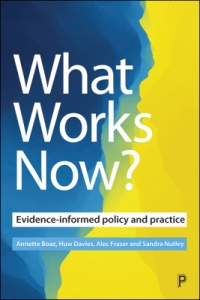In What Works Now? Evidence-informed Policy and Practice, Annette Boaz, Huw Davies, Alec Fraser and Sandra Nutley offer both a synthesis and critique of the rapidly evolving field of evidence-informed policy and practice. William Solesbury praises the timeliness, breadth and clarity of the collection.
What Works Now? Evidence-informed Policy and Practice. Annette Boaz, Huw Davies, Alec Fraser and Sandra Nutley (eds). Policy Press. 2019.
This is the third book on evidence and policy written by Huw Davies, Sandra Nutley and colleagues. In 2000 they published What Works? Evidence-based Policy and Practice in Public Services with Peter C. Smith and in 2007 Using Evidence: How Research can Inform Public Services with Isabel Walter. Edited with Annette Boaz and Alec Fraser, this latest book, like its predecessors, offers both a synthesis and a critique of a rapidly evolving field. Like them, it also draws on the work of scholars and practitioners, and it speaks to both. Its use of many text boxes to summarise sources or arguments is exemplary. This timeliness, breadth and clarity are its essential strengths.
The core of the book is a section of three chapters by the editors on generating evidence, assessing and labelling evidence and using evidence. On evidence generation they are keen to emphasise relevance as a criterion: that is, the diverse ways in which policy and practice need to be informed necessitates a diversity of knowledge sources which may make different, but complementary, contributions. But this does not preclude concern with how data, from whatever source, has been collected and analysed. On assessing and labelling evidence they are addressing the question of what counts as good evidence, for what purpose and in what contexts. Here they argue that evidence is not a disinterested knowledge base to underpin policy or practice. Rather it gets used as a resource that commonly interests draw on in advocacy. In the final chapter in this section they review models of the use of evidence, noting regretfully that linear approaches of ‘dissemination’ are still more dominant than those focused on relational approaches of ‘knowledge exchange’ or more systems-wide approaches for which the term ‘knowledge mobilisation’ has been coined. A useful text box provides examples, drawn from across the book, of these latter approaches.
These chapters are flanked by and informed by two other sections with chapters on the use of evidence in some UK policy and practice fields and in some international experience. These are authored by experts, 22 in all, familiar with those fields. It is a major achievement of the editors that, unlike so many collected works, they have brought coherence and consistency to these individual contributions.
The UK policy domains covered are healthcare, social care, criminal justice, education, environment and international development. Each chapter follows a similar structure under the headings of the nature of evidence in the field, the production and synthesis of research-based knowledge and encouraging and enabling evidence use. The first four fields were covered in the earlier books and here get a useful update. The last two – environment and international development – valuably bring some new experiences into the overall argument: for example, the role of international organisations, interdisciplinary contributions and the recognition of multiple perspectives.
The chapters on international experience cover, apart from the UK, Australia and New Zealand, Scandinavia, Canada and the United States. Again each is written according to the same structure as the chapters on policy fields. Some have a particular focus: for example, healthcare in Canada and education in the US. Quite a lot of similarity is on show but contextual differences, especially in political and professional development, also figure in the accounts. These are nearly all (with apologies to Scandinavia) essentially Anglophone countries: one wonders whether other, even European, countries would have a different story to tell?
The book has moved on from its predecessors in recognising the diversity of the policy and practice settings in which evidence is sought and gets applied: not just in evaluating effectiveness, but also in framing issues for action, engaging with audiences and developing options. It summarises these nicely under the shorthand headings of ‘know-about’, ‘know-what works’, ‘know-how’, ‘know-who’ and ‘know-why’. In this respect its retention of the phrase ‘What Works’ in the book title undersells its scope. The book also acknowledges the usefulness to policy and practice of evidence aside from research. Even so, the editors admit in several places that much thinking and action remain focused on and shaped by practice in identifying, assessing and applying research-based evidence. But it is noteworthy that, despite being themselves rooted in health and healthcare research, they are disdainful of the application of the long tradition of evidence-based medicine – ‘from bench to bedside’, as it is sometimes caricatured – to other domains. Again, a contrast with the earlier books is the adoption in its title of the phrase ’evidence-informed’ rather than ‘evidence-based’.
The book’s final chapter by the editors, titled ‘Evidence-informed Policy and Practice Revisited’, is brilliant. It notes how the political and economic context has changed in the almost two decades since their first book – here namechecking Michael Gove for his infamous Brexit remark that ‘people in this country have had enough of experts’. They then recount recurring themes: the continuing dominance of the ‘what works’ agenda; dispute over what counts as evidence; the enduring difficulty of getting evidence used; and the key importance of context. And then some recurring responses: broader expectations of evidence use; greater inclusivity of types of knowledge; greater expectations of lay participation; closer integration of the generation and use of evidence; and to achieve this, the need for action at many levels and on many fronts by diverse actors. All in all, they reaffirm their belief, and convince the reader, that evidence matters.
Note: This review gives the views of the author, and not the position of the LSE Review of Books blog, or of the London School of Economics.
Image Credit: (Pixabay CC0).


 Find this book:
Find this book: 






1 Comments